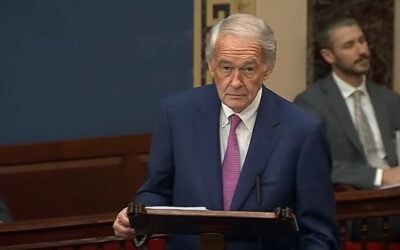
Last week’s Energy Storage Summit, held at the Victoria Park Plaza in London, brought together some of the biggest and best the industry has to offer.
The Energy-Storage.News team was on hand to document the event, picking out some key themes that emerged as the Summit entered its fifth year.
Enjoy 12 months of exclusive analysis
- Regular insight and analysis of the industry’s biggest developments
- In-depth interviews with the industry’s leading figures
- Annual digital subscription to the PV Tech Power journal
- Discounts on Solar Media’s portfolio of events, in-person and virtual
1. Interest in non lithium-ion storage is there, but there are challenges ahead
Whilst lithium-ion may have dominated many of the presentations and panel discussions at the two-day event, the signs of a growing appetite for non-lithium ion technology were certainly appearing. Talk turned to lithium-ion alternatives, and the longer duration and seasonal storage that often comes with it, in almost every panel discussion at the conference.
Across the conference, speakers agreed that storage may now be capable of solving intermittency as renewables come onto the grid, the big question is now to be seasonal storage, with hydrogen lauded as a possible solution by Manuel Baritaud, senior economist of the energy department of the European Investment Bank.
However, on a panel session dedicated to non lithium-ion technology, Gauthier Dupont, director of power business batteries at NGK Europe warned that cost competitiveness remains a huge challenge for alternative technology.
This, combined with a lack of visibility of new technologies and projects deployed by companies specialising in these technologies, means that lithium-ion alternatives are often overlooked, even when a technology might be better suited to that specific application, and funding difficult to secure.
Describing the discrepancy of R&D investment between lithium-ion and non lithium technologies as “a joke”, Dupont stressed the importance of access to investment and how partnerships are key to non lithium-ion storage.
“We have great technology, but we will not succeed alone,” Dupont said.
2. Revenue stacking continues to de-risk projects for investors as more firms turn to co-location
Revenue stacking is not a particularly new topic for the Energy Storage Summit, or for anyone making a profit – or attempting to make a profit – from energy storage.
However, greater weight is being given to the importance of projects having the agility to switch between multiple revenue streams, as well as the stacking of revenues through co-location with other low carbon technology, with the topic regularly acknowledged as one of the big enablers of storage throughout the event.
Access to a variety of markets, including frequency response, the UK’s Capacity Market and wholesale optimisation, was lauded as being what makes battery storage projects financially viable by EDF Energy’s director of energy solutions Vincent de Rul, adding that while it is a difficult market, “it is possible”.
The importance of multiple revenue streams was similarly stressed by the European Investment Bank's Manuel Baritaud, describing revenue stacking as what makes projects work economically.
Co-location of storage with other assets is key to the business models of companies like Gridserve and Pivot Power in the UK, with Pivot Power targeting electric vehicle chargers and Gridserve on EV chargers and solar generation.
However, for Gridserve battery storage acts as a “buffer” between the grid and the chargers, as well as the storage itself providing extra revenue for the charging site, the company’s chief investment officer Mark Henderson said.
Energy-Storage.news spoke to both Pivot Power and Gridserve ahead of the Summit to gain insight on the need for revenue agility and how collocation can boost a company’s business case.
3. ‘Storage with wheels’- but what to do with it?
Concurrent to the previous theme, the role electric vehicles (EVs) can play in the storage space as themselves a form of storage was also a topic widely discussed.
There was confidence from many of the speakers that electric vehicles are an area that will work, and that storage will play a big role in facilitating.
According to Rick Curtis, programme manager for Flex London at the Greater London Authority, storage could be “really, really useful” for putting EVs in areas with capacity constraints.
Roberto Castiglioni, founder and CEO of Ikigai Capital, described battery storage as “fundamental” to the deployment of EVs due to the need to balance the grid, as well as the opportunity for vehicle-to-grid (V2G) as every car is – and can become in terms of the grid – a mobile battery.
This was echoed by Northern Powergrid’s head of innovation Iain Miller, who said from a distribution network operator perspective, electric vehicles “are storage”.
“They’re storage with wheels on the bottom,” he continued, although he added that there does then come the question of what to do with that storage.
Whether or not V2G technology – one possible use case for this storage – is going to become commercially viable divided opinions throughout the conference. Gridserve’s Mark Henderson gave a very conclusive “no” when the topic came up during one of the final panel sessions of the event, and Northern Powergrid’s Iain Miller outlined that accessing vehicle storage doesn’t necessarily mean V2G, adding that vehicle-to-home is “significantly easier” than true V2G.
However, other speakers, including Stathis Mokkas, energy markets lead at UK Power Networks, lauded the technology as an important source of flexibility in years to come.
4. The industry must collaborate to solve future challenges
The storage industry may have opened up in recent years – as highlighted at the 2019 Energy Storage Summit – but greater collaboration is still required to push the industry forward and answer some of the questions being thrown at it, paritcularly surrounding regulation.
The Greater London Authority’s Rick Curtis stressed that there needs to be “much more bringing together of people” and joining up of discussions, especially in relation to colocation with EVs.
Meanwhile, Madeleine Greenhalgh, policy lead at Regen, urged that the UK storage industry needs much more diverse decision making, more people involved, and needs to be much more agile.
There are also a number of “technical, difficult questions we need to hammer out as an industry”, Greenhalgh said, pointing to the need for a discussion within the industry on what the optimum regulatory framework for storage would look like following a legal defintion for storage being created.
5. Regulatory hurdles still exist, but improvements are being made
Talk of the UK’s Targeted Charging Review (TCR) dominated several discussions at last year’s Energy Storage Summit, and it once again reared its head, being cited as a continuing barrier to energy storage.
Regulator Ofgem published its final decision on the TCR proposals in December 2019, which contained a mix of changes to the way network costs are recovered, including axing embedded benefits and the application of fixed residual charges, as opposed to a mix of per-unit consumption and peak demand charges.
Speaking on a panel session focused on commerical & industrial (C&I) storage, Ikigai Capital’s Roberto Castiglioni said the TCR “didn’t help at all” with deployment due to the removal of a “massive chunk of revenue” through triad avoidance.
“Things could have gone totally different” for C&I storage if the regulation didn’t change, he said.
Other regulatory issues at the forefront of discussions included the classification of storage as a subset of generation by UK regulator Ofgem, as well as how to enable the participation of storage in a variety of markets and whether there is a role for government in the creation of a market for long duration storage, or if this should be industry-led.
However, whilst there is “always more we can do”, Regen has seen the environment improve, with there having been “a lot of work in the last few years” to reduce regulatory barriers, Greenhalgh finished.






